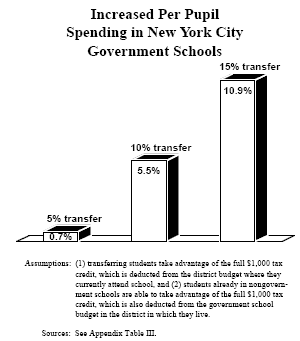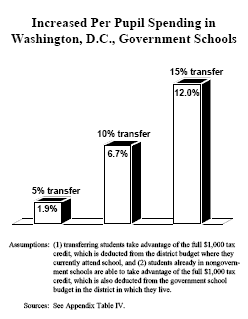About 92 percent of all money spent on elementary and secondary education in the United States is raised by taxes and goes to government schools. Because of the virtual government monopoly on education below the college level, parents have very limited options. Unless they can afford to pay for a private school in addition to paying taxes for government schools, their children must attend government schools even if those schools fail to meet the children's educational needs, are unsafe or lack discipline. These problems are especially acute in low-income inner-city neighborhoods.
This study proposes the Tax Credits Program for School Choice, offering tax credits to taxpayers who pay tuition for children to attend nongovernment schools. Using a $1,000 tax credit per child to illustrate the general concept, the program would work like this:
- Taxpayers – both individuals and businesses – would receive a dollar-for-dollar tax credit up to a maximum of $1,000 per child for money they spend on tuition expenses at any qualified nongovernment school.
- Those giving to charitable foundations that pay tuition for children from low-income families would also be eligible for the tax credit.
- Parents of children schooled at home also could reduce their taxes by $1,000 per child.
Every dollar of tax credit claimed would reduce revenue to state and local governments. This revenue loss would be paid for by a dollar-for-dollar reduction in the budget of the school district in which children attending nongovernment schools live. Taxpaying parents whose children already attend nongovernment schools could claim the credit. If as few as 5 percent of students transferred out of government schools, per pupil spending would increase in districts in most cases, since the $1,000 revenue lost to the government schools would be far less than is being spent now.
The $1,000 figure is used for illustrative purposes, but states might choose a higher or lower amount. However, the credit should be limited to an amount well below per capita spending in government schools for two reasons: (1) to allow per pupil spending in the government schools to increase each time a child transfers to a nongovernment school and (2) to discourage nongovernment schools from raising their tuition and fees in response to the tax credit program.
In addition to giving parents more control of their children's education by making nongovernment schools more affordable and making more money available to spend on children who remain in the public school, the Tax Credits Program for School Choice would:
- Help urban areas hold on to taxpayers who are now moving out of cities in search of better schools in the suburbs and businesses that follow taxpayers to those suburbs.
- Eventually reduce local education tax rates as the taxes raised prove to be more than sufficient to educate children in government schools.
- Stimulate competition among all schools, creating incentives to improve the quality of education everywhere – especially in low-income areas.
Since people would be spending their own money, not "government money," the program should remove constitutional questions about tax funding for religious schools and preclude increased government oversight of private schools.
[page]In the last 10 years, a nationwide movement has emerged in favor of school choice — the use of market forces to give parents greater control over their children's education, to improve learning and to control government school costs.1 The impetus behind that movement is the growing dissatisfaction with government schools, which now control 92 percent of all money spent on elementary and secondary education. A majority of parents are unhappy with those schools.
- In a 1995 survey, almost six of every 10 parents with children in government schools said they would send them to private schools if they could afford to do so.2
- An NBC News/Wall Street Journal poll in 1997 found that 94 percent of Americans want significant change in the public education system – and 69 percent want parents to have more control over their children's education.3
"A majority of parents are unhappy with government schools."
Parents, taxpayers, business groups, elected officials and civic leaders increasingly object to skyrocketing costs, poor quality, high drop-out and truancy rates, incorrigible bureaucracy, resistance to reform, crumbling buildings, worsening violence, lack of standards and accountability and the absence of instruction in morality.
The public policy proposals most often put forward in response are:
- Tuition vouchers — government gives low-income parents tax-funded vouchers to help pay tuition at nongovernment schools.
- Charter schools — government fully funds a limited number of existing or new schools that are exempt from most regulations and free to design their own curricula.
- Public school choice — parents are allowed to choose their children's schools from existing government schools, either in or outside of their district.
- Contracting out — school districts contract with private companies for teaching, management or support services now provided by district employees.
All four approaches would enhance school choice. But all present operational, political and legal difficulties that are discussed below.4 This paper describes a fifth proposal, the Tax Credits Program for School Choice: tax credits for individuals and companies who help to pay children's nongovernment school tuition, thus relieving government schools of the task of educating a child.5
This program is not designed to solve all education problems for everyone everywhere. However, it could be part of the solution, possibly in addition to other kinds of school choice plans. It could provide the means for a significant number of elementary and secondary school students to leave government schools, giving critical relief to overburdened school districts, to parents who want a different kind of education for their children and to taxpayers straining under the high cost of government education.
Of equal importance, the program speaks to concerns about possible unwanted government intervention in the operation of private schools and about the constitutionality of using government funds for religious schools. With tax credits, the money never becomes "government money"; instead taxpayers are able to keep their own money to use toward education.
[page]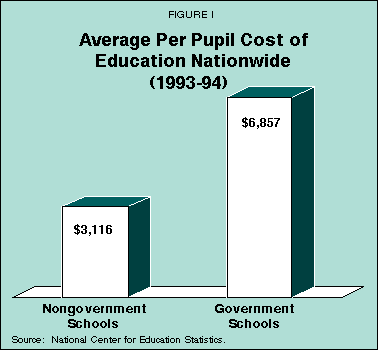
"The Tax Credits Program for School Choice would provide more money per pupil to the government schools."
Despite growing budgets over the last few decades, government schools most often say more money is the answer to many of their problems. The Tax Credits Program for School Choice would provide more money per pupil to the government schools, while at the same time giving taxpayers control of more of the money spent on elementary and secondary education and more choice over where and how it was spent. The playing field would not be level; this proposal is tilted in favor of government schools. Nonetheless, government and nongovernment schools would compete.
Taxpayer Choice. Using $1,000 per child to illustrate the general concept, the Tax Credits Program for School Choice would work as follows:
- Taxpayers — both individuals and businesses — would receive a dollar-for-dollar tax credit up to a maximum of $1,000 per child for money they spent on tuition expenses at nongovernment schools.
- The credit also could be applied against gifts to charitable foundations set up to pay tuition for children from low-income families.
- Taxpayers who homeschool their children would be eligible for a $1,000 per child tax credit without having to document any expenses.
- The budget of the education district in which the child lives would be reduced by the amount of the credit.
Qualifying for Tax Credits. To receive a tax credit for out-of-pocket expenses, taxpayers would not have to pay a child's full tuition.6 They could pay only part. Taxpayers also could pay part or all of the tuition of children other than their own. Only a maximum credit of $1,000 per child could be claimed, even though actual tuition might be greater than that amount. For example, three taxpayers could not contribute $1,000 each to pay the $3,000 tuition for one child and then claim $3,000 of tax credits. However, a business or individual could pay $1,000 tuition for each of 10 children and claim a $10,000 tax credit. The $1,000 per child limit could be audited by using the child's Social Security number. (See "Administering the Program" below.)
Selecting the Amount of the Credit. This study uses a $1,000 tax credit for illustrative purposes because it seems to work well in various Pennsylvania school districts sampled by the author. However, the preferred tax credit amount might be more or less in other states, depending on current spending in government schools and current enrollment in nongovernment schools. (In departures within this study, a $1,200 tax credit is used in New York City and Washington, D.C., examples.) Choosing a limit well below the per pupil cost of government schools would:
- Ensure that spending on students who remain in government schools would in most cases stay the same or increase.
- Reduce the likelihood that nongovernment schools would raise tuition in response to the tax credit program.
The U.S. Department of Education reports that the average per pupil cost of government schools nationwide is $6,857. Thus government schools would have $5,857 ($6,857 minus the $1,000 revenue loss) extra to spend on the remaining students after a student transfers to a nongovernment school.
Is $1,000 enough to induce families to transfer their children to nongovernment schools? That amount would put a small dent in the $12,000 tuition charged by elite private schools. However, such expensive schools are in the minority. As Figure I shows, most nongovernment schools charge far less.7
- The average annual private elementary school tuition nationwide is less than $2,138.
- With private secondary schools included, the average tuition is $3,116.
- About 67 percent, more than 17,000 private elementary and secondary schools, charge $2,500 or less, and 19 percent charge less than $1,000.
"The 'cost' of all tax credits would be deducted from the school district budget where the taxpayer pays taxes."
Options for Funding the Credit. Policymakers have numerous options for designing a tax credit. A reasonable approach would be to apportion the credit between state and local taxes, based on the way public schools are currently funded. For example, if states and localities fund schools in roughly equal proportions, a $1,000 credit might be divided into a $500 state tax credit and a $500 local tax credit. Tax credits could be applied against state general fund taxes that support education such as personal income taxes, corporate net income taxes and inheritance taxes. At the local level, the credit could be taken against direct school district taxes (usually property taxes) or against taxes on income. The "cost" of all tax credits would be deducted from the appropriate school district's budget.
Potential Use of the Credit. Not all parents would choose to transfer their children from government schools to nongovernment schools. Many would be unable to afford it even with the tax credit. Others would not immediately find a nongovernment school that fit their children's needs. But the high percentage of parents with children in government schools who say they would prefer nongovernment schools clearly indicates the potential demand. The response of low-income families in a number of cities to the private scholarship programs discussed below is another indicator.
Even "School Choice," published in 1992 by the Carnegie Foundation for the Advancement of Teaching and widely criticized as biased against school choice, demonstrated a significant demand for private schools. The report included a nationwide telephone survey of about 1,000 parents, who were asked, "Is there some other school to which you would like to send your child? This school could be public or private, inside or outside of your district, within your child's grade level." Nineteen percent said they would like to send their child to a private school. According to the National Association of Independent Schools (NAIS), total enrollment in independent schools in the last decade jumped 11 percent, with elementary school enrollment rising even faster, at 18 percent.
[page]The Tax Credits Program for School Choice offers gains for schools, students, parents, cities, taxpayers, education entrepreneurs and businesses concerned about education.
"This proposal could be described as the 'Government Schools Relief Program,' since government schools would have more money to spend per student."
Benefits for Government Schools. If, as government school officials often claim, more money is the answer to their problems, then tax credits for school choice would help solve those problems for, as shown below, under almost any reasonable scenario government schools would gain. In fact, this proposal could be described as the "Government Schools Relief Program." Since most of the money would remain when pupils leave a government school, per pupil spending on the remaining students would rise. In addition, a smaller enrollment would alleviate the need for larger classes and expanded capital budgets for government schools.
Benefits for Students from Low-Income Families. Rather than giving money to government, taxpayers could help children from low-income families achieve a better education. This program would enable all taxpayers to decide where to send the taxes they owe. Although benefactors could receive a tax credit of no more than $1,000 per child, many might contribute more and deduct the contributions as charity on their federal tax returns.
The $1,000 tax credit likely would allow a large fraction of current government school students to attend nongovernment schools if they chose to do so. The tax credit would not guarantee a Cadillac education for everyone, but it would afford many more students a good-quality Chevy. Even those who chose to stay in government schools would be better off. As noted above, those children would benefit from the increased per pupil spending.
Contributions to private scholarship programs offering tuition assistance to children of low-income parents also would be eligible for the tax credit. The Children's Educational Opportunity Foundation (CEO America), a nationwide umbrella group of private voucher programs based in Bentonville, Ark., reports that more than 13,500 children from low-income families are in the programs currently in operation in 30 cities, including Washington, D.C., Dallas, Indianapolis, Philadelphia, Atlanta, San Antonio, Oakland and Little Rock. Aid ranges from $3,000 per student in Atlanta to $750 in San Antonio and Oakland.8 In these private voucher programs, the families pay a share of the tuition — usually about half. Even so, more than 20,000 still in government schools are on waiting lists.9 Of course, many private and religious schools offer tuition assistance to students. For every one of these programs, the demand for assistance far exceeds the supply. Tax credits for school choice could expand the supply.
Benefits for Parents. The program would give parents more options. An important reason why more children do not attend nongovernment schools is financial.10 Many parents cannot afford to pay both taxes and tuition. Tax credits would partially remedy that unfairness. Homeschooling parents would also get tax relief. And unlike voucher proposals that target only children in low-income families, tax credits would benefit all parents.
Even those who chose to leave their children in government schools would gain influence over the quality of curriculum and teaching there. School officials, keenly aware that the parents had a choice of schools, would be strongly inclined to increase parental satisfaction.
"More middle-income families would be induced to stay in the cities."
Benefits for Cities. Education tax credits could become an important economic development and neighborhood preservation tool for inner cities. To survive, cities need taxpaying residents and businesses. But because the quality of so many urban schools is so poor, many families leave the cities in search of better schools in the suburbs. That migration in turn affects where businesses locate. The tax credit proposal developed here would induce more middle-income families to stay in the cities and send their children to nongovernment schools if they were dissatisfied with the available government schools.
Benefits for Taxpayers. This proposal moves students out of high-cost into low-cost schools. Moreover, capital and operating budget pressures due to projected enrollment increases would decrease. The need to build more government schools and to hire more teachers would diminish. In time, as the taxes raised proved more than sufficient to educate children in government schools, elected officials would face pressure to lower tax rates.
Benefits for Education Entrepreneurs. People and groups wanting to start new schools likely would find it easier to raise the capital to do so when the new tax credits increased the demand for nongovernment schools. The growth in nongovernment school population would stimulate innovation in the private education market.
Benefits for Businesses Concerned about Education. For the last 15 or 20 years, many businesses have supported school reform efforts through partnerships, loaned executives, donated equipment and outright cash grants. Although those efforts may have improved the education of individual students, government school systems have resisted fundamental reform and remain inefficient. Tax credits would encourage both large and small businesses to make an immediate difference in education — rather than enduring years of wrangling while school reform legislation is hammered out and charter schools approved. Without delay they could:
- Set up schools for their employees' children and others; the schools could even specialize in teaching skills of particular use to the business sponsor.
- Use their education tax dollars to pay tuition at existing nongovernment schools they deem worthy of support.
- Contribute to private scholarship funds.
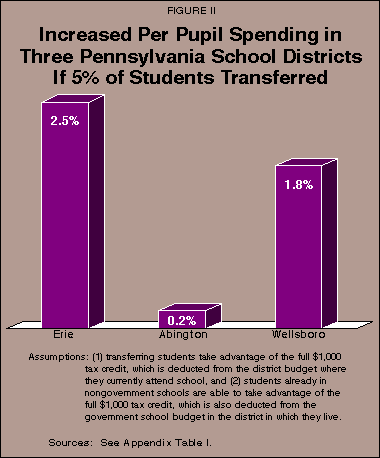
How might the Tax Credits Program for School Choice work? Even though the credits, including those for pupils already in nongovernment schools, would be deducted from the appropriate school district's budget, per pupil spending would rise in almost all cases if as few as 5 percent of those now in government schools transferred. This is because no more than $1,000 per pupil would be deducted – far less than the amount now being spent.
In a few districts, large numbers already attend nongovernment schools. If the full credit were claimed for all those pupils and only a small percentage transferred from government schools, per pupil spending might fall. In those rare instances, the state government could make up any lost revenues.
This section examines the results in some Pennsylvania districts if 5 percent of pupils transferred from government to nongovernment schools. It also looks at two large districts often cited for the problems of their schools, New York City and Washington, D.C.
Case Study: Three Pennsylvania School Districts. Figure II shows the effects of the program on local school operating budgets in three selected districts in Pennsylvania. [Details of the calculations are in Appendix Table I.] If 5 percent of government school students moved to nongovernment schools and all current nongovernment school students claimed the full tax credit:
- Per pupil spending for government schools in Erie, a low-income district, would increase by 2.5 percent without increasing total spending.
- In Abington, a suburban district, per pupil spending would increase 0.2 percent.
- In Wellsboro, a rural district, per pupil spending would increase 1.8 percent.
The per pupil spending increase would be higher still if more than 5 percent left for nongovernment schools.
"Twenty-five percent of Philadelphia school children already attend nongovernment schools."
Case Study: Philadelphia. Philadelphia is probably one of the few exceptions in Pennsylvania. There, slightly more than 5 percent would have to leave government schools to increase per pupil spending. Because of parental dissatisfaction with troubled government schools, 25 percent of schoolchildren in the Philadelphia school district already attend nongovernment schools. As Figure III shows:
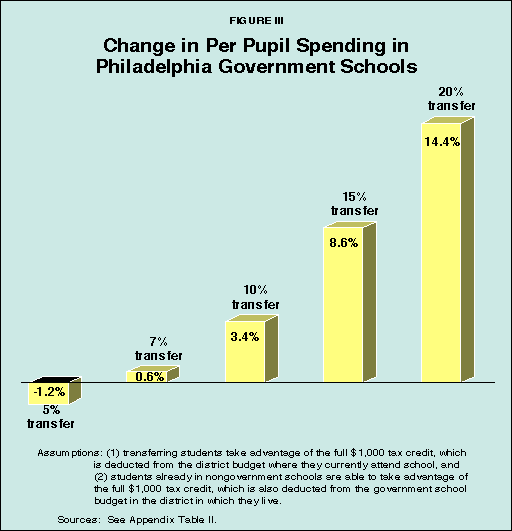
- If only 5 percent of the 211,658 students in government schools moved to nongovernment schools and all nongovernment students claimed the full tax credit, per pupil spending would decrease 1.2 percent, from $6,374 to $6,296.
- If 7 percent moved, per pupil spending would increase 0.6 percent, from $6,374 to $6,410.
It seems likely that at least 7 percent of current government school students would leave if credits were available. If more did so, per pupil spending for children remaining in Philadelphia's government schools would rise further:
- If 10 percent of the students in the Philadelphia government schools left, per pupil spending would increase by more than 3 percent.
- If 15 percent left, per pupil spending would increase almost 9 percent.
- And if 20 percent left, the increase would exceed 14 percent.
"In Philadelphia, per pupil spending would increase if slightly more than 5 percent of students left government schools."
Case Study: Other Large City School Systems. New York City, the nation's largest public school system, and Washington, D.C., arguably the nation's worst, could increase per pupil spending if as few as 5 percent of students moved to nongovernment schools, even if the tax credit were expanded to $1,200. This would be true even if the credit went to the 20 percent of all schoolchildren in New York who are already in nongovernment schools. Only 12 percent are in nongovernment schools in Washington, so per pupil spending in government schools there could go up almost 2 percent if 5 percent of government school students transferred to nongovernment schools. [See the sidebars, "School Tax Credits in New York City" and "School Tax Credits in Washington, D.C."] [Appendix Table III] [Appendix Table IV]
[page]The tax credits program would be reasonably simple to administer. One line would have to be added to the forms of states with personal and business income taxes. Local administration would be equally simple.
Administering the Program: State Tax Credit. A simple tax credit schedule, similar to those used for existing Pennsylvania tax credits and for property tax and rent rebates, would be developed. [See the appendix (part 1) (part 2) (part 3) for an example.] Taxpayers could claim the $500 state tax credit (assuming the credit were divided equally between state and local taxes) only up to the amount of state taxes actually paid (business or personal). The tax credit could be applied against almost any tax that is deposited into the general fund and allocated to the state department of education budget. These could include personal income taxes, corporate net income taxes and inheritance taxes. The tax credits would be deducted from department of education accounts that currently assist local government schools. States without these taxes might have to take a slightly different approach to give the credits.
"The additional administration required for the credit should be minimal once it is set up."
Administering the Program: Local Tax Credit. The program might create additional or different administrative duties for local tax collectors. However, in this age of computers, databases and private tax collection contractors, once it is set up the additional work and expense should be modest. If local school district support is from real estate taxes only, the additional administration should be minimal. The property tax bill could include the above-mentioned tax credit schedule certifying that taxpayers are homeschooling their children or paying tuition at a nongovernment school for their children or someone else's. Taxpayers could then subtract $500 per child from their property tax bills up to the full amount owed.
If the school district is supported from additional local taxes, such as earned income and occupation taxes, a central tax collector could collect all local taxes, and all tax credits could be claimed at once on the form described. To avoid bureaucratic and administrative difficulties, the central tax collection function could be privatized. Taxpayers could then subtract $500 per child from their combined real estate, earned income and occupation tax bill up to the full amount owed.
Administering the Program: General. For auditing and record-keeping purposes, taxpayers claiming the credit would be required to provide either (for parents) the child's Social Security number or (for nonparents) a number assigned by the school to the child who was benefiting. Schools would issue an annual statement (like the federal government's W-2 employment statement) to those taxpayers who plan to take the tax credit. [See the appendix (part 1) (part 2) (part 3) for an example.] Like any tax collection process, these tax credit claims would be subject to random audits.
[page]A few states have pioneered in either tax deductions and/or tax credits, applicable to both government and nongovernment school expenses. Some of the laws have withstood court challenges; others have yet to be tested.
"Some pioneering tax credit plans have withstood court challenges; others have yet to be tested."
Minnesota. For more than a decade, Minnesota has allowed taxpayers, in computing their state income tax, to deduct expenses for tuition, nonreligious textbooks and transportation for their children. The deduction, originally up to $650 for elementary schools and $1,000 for secondary schools, was recently increased to $1,625 and $2,500.
It can be taken for expenses in any nonprofit secular or nonsecular school or in any government school. Parents of children in government schools also can deduct supplemental, education-related expenses. In June 1997, Minnesota added a "refundable" education tax credit of $1,000 per child or $2,000 per family for families with incomes of $33,500 or less. The credit does not apply to private school tuition.
Iowa. An Iowa law passed in 1987 allowed taxpayers to itemize and deduct up to $1,000 of textbook and tuition expenses. It also provided, for taxpayers who use the standard deduction, a credit of 5 percent up to $1,000 for these expenses for each dependent. The law applied to both government and nongovernment school expenses, but only for taxpayers whose net income was $45,000 or less. In 1996 the Iowa Legislature replaced this law with a new statute that eliminated the deduction and raised the tax credit to 10 percent of the first $1,000 the taxpayer pays for tuition and textbooks, with a maximum credit of $100 per child. The new law allows the credit regardless of net income.
Arizona. Arizona passed an education tax credit law to take effect in 1998, but it takes a completely different approach. Taxpayers can take a credit of up to $500 for donations to charitable organizations that provide scholarships for children to attend private or parochial schools — but the donations cannot be used for the taxpayer's own dependents.
[page]Tax credits could deliver many of the benefits offered by other kinds of school choice, enabling parents to choose schools with the quality and values they prefer and saving taxpayers money. Tax credits have additional political, legal and administrative advantages.
Advantages over Vouchers. Some critics say that giving "government money" (vouchers) to private and religious schools is wrong. A related criticism is that it is unconstitutional. Although opponents of educational freedom are sure to take any reform to court, tax credits have overcome First Amendment church-state objections. The original Minnesota law withstood a court challenge in 1983.11 In holding that the statute did not violate the First Amendment's establishment clause, even though it primarily benefited religious schools, Chief Justice William Rehnquist wrote for the majority:12
Finally, private education institutions, and parents paying for their children to attend these schools, make special contributions to the areas in which they operate. Parochial schools, quite apart from their sectarian purpose, have provided an education alternative for millions of young Americans; they often afford wholesome competition with our public schools; and in some states they relieve substantially the tax burden incident to the operation of public schools [emphasis added]. If parents of children in private schools choose to take especial advantage of the relief provided by [the statute], it is no doubt due to the fact that they bear a particularly great financial burden in educating their children.More fundamentally, whatever unequal effect may be attributed to the statutory classification can fairly be regarded as a rough return for the benefits, discussed above, provided to the State and all taxpayers by parents sending their children to parochial schools.
"There is no reason a tax credit should be considered government aid to education."
There is no reason a tax credit for nongovernment school tuition should be considered government aid to education. Americans routinely lower their federal income taxes by deducting charitable contributions to religious organizations. No one regards that provision as government aid to religion. [See the sidebar, "Ensuring Constitutionality."]
Some advocates fear that government control of nongovernment schools through regulations may come with vouchers. Any time government passes out checks, they say, it adds a bureaucracy. Even with statutes to prevent new interference, there is cause for concern. The concern is minimized with tax credits, since the relationship between the government and students in nongovernment schools would not change and people would clearly be spending their own money.
Advantages over Charter Schools. Legislating tax credits would be faster and more efficient than building charter schools. Years pass while lengthy, complicated and restrictive charter school legislation is hammered out and new schools are approved. With tax credits, educators, parents, nonprofits, religious organizations and businesses could set up new schools the day after a state approved the program. The stimulus of the tax credit alone would increase the demand for nongovernment schools.
Advantages over Public School Choice. Public school choice does not give parents real choice; it offers only a choice of schools run by the same bureaucratic monopoly. It does not address the wishes of parents who would like their children to attend schools that embody their values. It does nothing to control education costs for taxpayers. Tax credits would do all those things.
Advantages over Contracting Out. Although contracting out educational services by the local school district can have some benefits — reduced costs, increased quality, better accountability — a third-party bureaucracy still purchases the services. Parents have little control. The tax credits program would increase their control significantly.
"Tax credits offer better accountability and less politics."
Other Advantages. Tax credits offer two other advantages: better accountability and less politics. An important administrative problem for charter schools or contracting out is accountability. Who ensures that the government's money is well spent and that children get an education that satisfies their parents? However localized the governing bodies are, charter school and contracting-out plans grant the greatest measure of control to a third party — not to parents. Decisions are likely to be political, not educational, cost-efficient or value-rich.
The best mechanism for accountability is the marketplace, monitored and controlled by consumers acting in their own self-interest. Parents participating in the tax credits program would exercise consumer power, choosing the best education available for their children.
Tax credits would blunt many of the political questions about school choice, such as:
- How would we determine which students get voucher money?
- Should government voucher money be used in schools that teach witchcraft or racial and ethnic hatred?
- How would we decide who can set up a charter school and who cannot?
"The quality of goods and services is highest when consumers are free to choose and entrepreneurs are free to provide."
Under the tax credits program, these arguments would become irrelevant because the money would not be the government's. The program would not attempt to control any child's education. It would let parents send their children to nongovernment schools, a constitutional right set forth by the U.S. Supreme Court in 1927. It would allow taxpayers who relieve a government school of the task of educating a child to enjoy more control over their own money.
[page]Long experience has taught that the quality of goods and services is highest when consumers are free to choose and entrepreneurs are free to provide. American education, monopolized by government, has ignored this experience. Predictably, progress in education has been slow and uneven. If education is to prepare children for the 21st century, parents must be allowed to make the key educational decisions and entrepreneurs must be encouraged to offer educational products and services directly to parents and schools. The route to educational progress is via parental control of education spending. The tax credits for educational choice program would be a first, giant step.
NOTE: Nothing written here should be construed as necessarily reflecting the views of the National Center for Policy Analysis or as an attempt to aid or hinder the passage of any bill before Congress.
[page]Questions and Answers About the Tax Credits Program for School Choice
1. How can taxpayers use the tax credit to transfer money from government schools to nongovernment schools?
No government money is transferred from government schools to nongovernment schools. Individuals and businesses can avoid transferring their money to the government schools in the first place by showing on their tax return that they have relieved the government schools of the task of educating a child.
2. Isn't there a difference between the timing of tuition payments (September) and tax payments (often the next April)? How would the program deal with this difference?
Since different taxes are due at different times of the year, it's up to individual taxpayers to budget their funds to be available when their child's tuition is due, or when they want to contribute to pay another child's tuition. Most nongovernment schools have payment plans allowing tuition to be paid in installments through the school year.
3. How does the government know which credit goes with which student, and if or when the $1,000 per student maximum has been exceeded?
For auditing and record-keeping purposes, taxpayers claiming the credit would be required to provide either (for parents) the child's Social Security number or (for nonparents) a number assigned by the school to the child who was benefiting. Schools would issue an annual statement (like the federal government's W-2 employment statement) to those taxpayers who plan to take the tax credit. [See the appendix for an example.] Like any tax collection process, these tax credit claims would be subject to random audits.
4. Isn't this a roundabout way of using government money to subsidize private and religious schools?
No, allowing citizens to keep their own money to spend as they choose is not a subsidy. Our country was not founded on the premise that the government owns everything and allows citizens to keep portions of it. Taxpayers have every right to spend the money they have earned. While the program does not end tax coercion for education, it does give taxpayers more control over how much and where the money is spent.
5. If parents owe only $500 of state and local taxes, where does the rest of the tuition come from?
It is true that parents with very low incomes who pay only $500 in total state and local taxes may not realize the full benefits of the Tax Credits Program for School Choice if they pay tuition over $500. However, parents like these with very small incomes are likely to benefit from school-based scholarship programs at individual schools. Further, they are the ones who would benefit from general tuition assistance programs that would be established as individuals and businesses use their tax credits to help the children of others attend nongovernment schools. As mentioned in the study, this one program – the Tax Credits Program for School Choice – will not solve all education problems for everyone everywhere. Other policies and programs are in place or are being proposed for the kinds of circumstance not addressed by tax credits.
6. Why is this a tax credit, not a tax deduction?
In general, only a tax credit can provide a dollar-for-dollar exchange between the government schools' budgets and individual taxpayers' tuition payments. This is an issue in Pennsylvania, where some of the case studies were based, and it may be in other states. The Pennsylvania Supreme Court has ruled that tax deductions are unconstitutional because they violate the uniformity clause of the Pennsylvania Constitution, which requires that all taxpayers be treated the same. However, tax credits have not been ruled unconstitutional in Pennsylvania. In fact, Pennsylvania has four tax credits to taxpayers who perform certain actions deemed beneficial to society: Neighborhood Assistance Credit, the Employment Incentive Payment Credit, the Mortgage Emergency Assistance Fund Credit and the Job Creation Tax Credit. A previous credit, the Economic Revitalization Tax Credit, has expired. In addition, Pennsylvania allows property tax and rent rebates for lower-income taxpayers.
7. What happens when a special (more-expensive-to-educate) student transfers out of a government school?
States should consider offering a bigger tax credit for special education students – especially if the state's accounting systems are set up to identify all costs for special education students, and it can be shown that significantly more money is being spent for these students and significantly more money would be saved if they left.
8. Wouldn't this program radically alter the complicated funding formulas many states use to subsidize local school districts and thus cause political turmoil?
In terms of accounting at the state budget level, the tax credits would be "deducted" from department of education accounts that currently assist local government schools. For example, Pennsylvania allocates more than $5 billion of state tax money to local school districts, including school district employees' retirement costs. Seven major subsidy programs provide state funding to school districts. The Equalized Subsidy for Basic Education, or ESBE, formula serves as the base for the state's subsidy funding for school districts. In most programs, the funds are distributed inversely according to wealth in the local district and are based primarily on enrollment (often using "average daily attendance" calculations). The ESBE formula might have to be altered somewhat to accommodate the Tax Credits Program for School Choice, but its basic emphasis on levels of enrollment, relative wealth and special characteristics of school districts need not be changed. If enrollment decreases 5 percent, 10 percent or 15 percent because of tax credits, state subsidies could be adjusted and assistance decreased by the amount of the tax credits. The concern expressed here is an accounting problem that may be difficult for internal managers at the department of education to solve. The Secretary of Education (the title varies from state to state) should issue a Request for Proposals asking knowledgeable and experienced professional accounting firms to propose internal accounting procedures that would least disrupt the current funding formula.
9. What happens to the tax credit if a student moves to a nongovernment school – or returns to a government school – during the school year?
Probably the best way to keep administration of the tax credit simple is to allow the tax credit for a full school year only.
10. Could taxpayers in one school district pay tuition for students in another school district?
Since a taxpayer gets a credit only for taxes paid, there would be no local tax credit for paying tuition in a school district where the taxpayer had paid no local taxes. However, assuming the credit was apportioned between local and state governments, a taxpayer who had paid state taxes would qualify for the state portion of the credit.
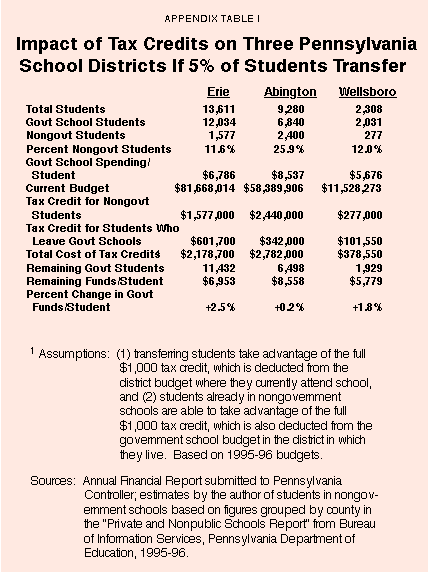

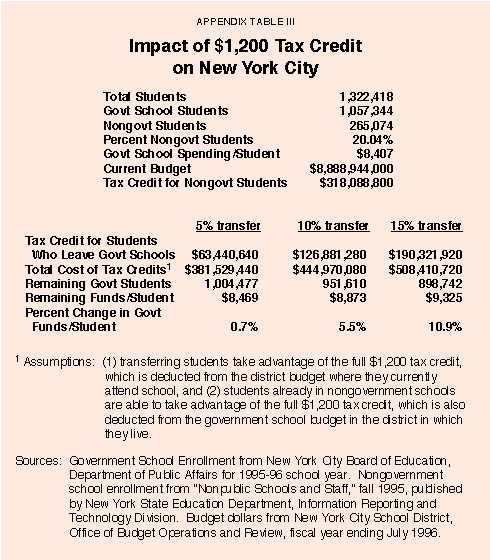
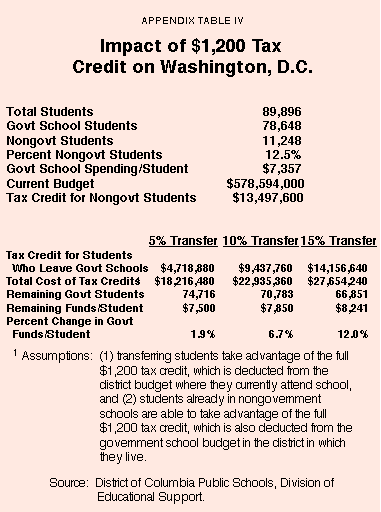
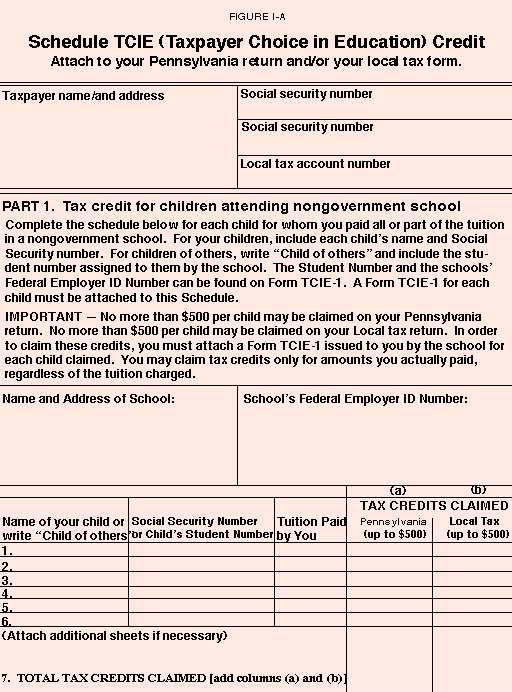
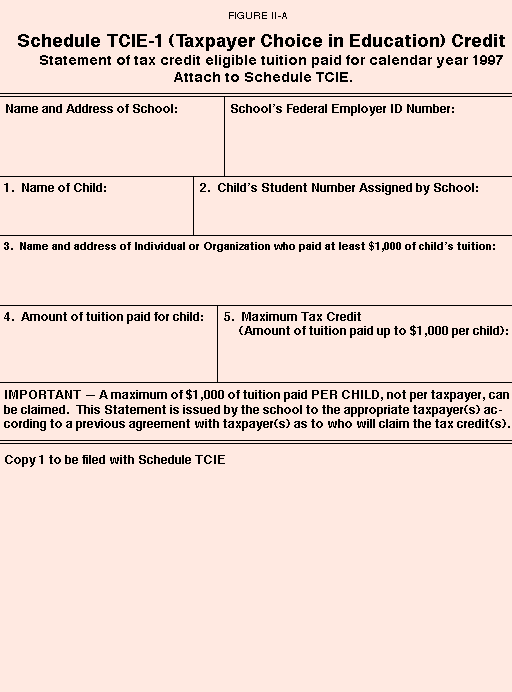
-
The terms government and nongovernment schools are used for reasons best summed by the National Scholarship Center in "The 1995 Annual Survey of the Private Voucher Movement in America":
For the twin purposes of clarity and accuracy, we use the term government schools to denote those schools owned and/or operated by a government entity; accordingly, we use the term nongovernment schools to denote private, parochial, religious or independent schools. The reason is simple and unprovocative. In the first case, the chief unifying characteristic of what are known as public schools is the fact that they are all government-owned and government-operated – thus the term, government schools. In the second case, the sole unifying characteristic among the universe of private, parochial, religious or independent schools is that none of them are government-owned or government-operated — thus the term, nongovernment schools. The most obvious alternative pair of terms — public and nonpublic — is unacceptable since it implies that while the former group serves the public, the latter group does not. -
Assignment Incomplete (New York: Public Agenda and Institute for Education Leadership, 1995).
-
See Elie Pieprz, "Arizona Leads the Way on School Reform," Investor's Business Daily, May 13, 1997.
- See the section "Advantages over Other School Choice Plans."
- This paper is based on a proposal originally constructed for the Commonwealth of Pennsylvania. Pennsylvania controls and funds its educational system the way most states do. Government schools are funded primarily through local taxes. State taxes provide most of the remaining funds. Control is divided between state and local authorities. Thus, although most of the examples apply to Pennsylvania, they are equally instructive for policymakers in other states.
- No one could receive a tax credit worth more than the tax paid; this is not a negative credit.
- See David Boaz and R. Morris Barrett, "What Would a School Voucher Buy? The Real Cost of Private Schools," Cato Institute Briefing Paper No. 25, March 26, 1996, p. 8.
- "1995 Annual Survey of the Private Voucher Movement in America," National Scholarship Center, Washington, D.C. The latest count of the number of cities with private school voucher programs was confirmed in a telephone conversation with Fritz Steiger, president, Children's Education Opportunity Foundation (CEO America), Bentonville, Ark., February 27, 1997.
- "The Voucher Voice," Children's Education Opportunity Foundation (CEO America), Bentonville, Ark., Winter 1995, and conversation with Fritz Steiger, president.
- According to a marketing survey conducted in 1993 by the Catholic Diocese of Pittsburgh, the biggest disadvantage of nongovernment schools cited by parents was cost. Nationally, the average tuition for Catholic elementary schools is $1,280. See "Balance Sheet for Catholic Elementary Schools, 1995 Income and Expenses," National Catholic Education Association, Washington, D.C. High school tuition averages more than $3,300. See "Dollars and Sense: Catholic High Schools and Their Finances, 1994," National Catholic Education Association, Washington, D.C.
- The 1997 tax credit law has not yet been tested in court.
- Mueller v. Allen, 463 U.S. 388, June 29, 1983.
Linda Morrison, a Senior Fellow of the National Center for Policy Analysis, is a public policy consultant based in Newtown, Pa., who was competitive contracting advisor to New Jersey Gov. Christine Todd Whitman and Director of Competitive Contracting for Mayor Ed Rendell of Philadelphia. Ms. Morrison was one of eight members of an expert panel on state and local privatization assembled by the General Accounting Office to assist that agency with a study it was conducting for the U.S. House Republican Panel on Privatization. She has advised other elected officials and candidates on a variety of issues involving the use of market forces to solve public policy problems and has written extensively on these subjects.
